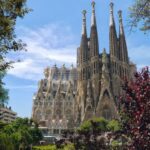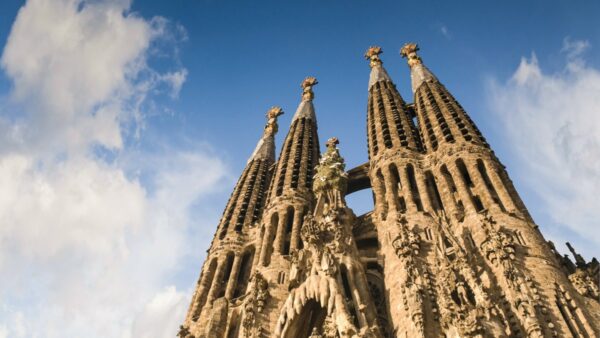
Barcelona, a city renowned for its stunning architecture and vibrant culture, is home to one of the world's most iconic landmarks: the Sagrada Familia. This basilica, designed by the visionary architect Antoni Gaudí, captivates visitors with its intricate facades and towering spires that reach toward the heavens.
In this exploration, we delve into The Majestic Barcelona Towers: Unveiling the Magnificence of the Sagrada Familia, highlighting the architectural brilliance and artistic details that make this masterpiece a testament to Gaudí's genius. Each tower tells a unique story, contributing to the basilica's grandeur and cultural significance, making it a must-see for anyone visiting the city.
The Architectural Wonders of the Barcelona Towers: A Deep Dive into the Sagrada Familia
The Barcelona Towers of the Sagrada Familia are not merely structural elements; they are symbolic representations of the Gospels and the holy figures they embody. Each of the eighteen towers is dedicated to a significant biblical character, with the tallest tower representing Jesus Christ, reaching an impressive height of 172.5 meters. This meticulous design reflects Gaudí’s vision of a church that harmonizes with nature and spirituality.
In addition to their religious significance, the towers showcase various architectural styles, blending Gothic and Art Nouveau elements. The intricate mosaics and sculptures adorning the towers contribute to the overall aesthetic, with materials sourced from different regions, including ceramics, glass, and stone. This fusion of textures and colors enhances the visual spectacle, inviting admiration from every angle.
- Structural Innovation: The towers utilize hyperboloid structures that provide both stability and beauty.
- Symbolic Heights: Each tower's height is calculated to create a harmonious skyline.
- Natural Integration: The design incorporates natural light, enhancing the spiritual atmosphere inside the basilica.
Furthermore, Gaudí’s use of geometry and nature-inspired forms leads to a unique interplay of light and shadow within the Sagrada Familia. The towers are crowned with distinctive pinnacles, which are designed to mimic natural elements such as fruits and flowers, further solidifying the connection between architecture and nature. This breathtaking integration not only serves a decorative purpose but also enriches the religious experience for visitors.
Exploring the Symbolism Behind the Sagrada Familia's Tower Designs
The Sagrada Familia’s towers are not just architectural feats; they are imbued with profound symbolism that reflects the essence of Christianity. Each tower represents a key figure from the Gospels, with the tallest one symbolizing Jesus Christ. This intentional design showcases Gaudí's desire to create a space that elevates the spirit and connects the earthly with the divine.
Moreover, the towers embody the concept of spiritual ascension. Their varying heights are thoughtfully calculated to echo the hierarchy of heaven and earth, with the tallest reaching towards the sky as a symbol of aspiration and faith. This verticality is not merely aesthetic; it serves to inspire visitors to contemplate their own spiritual journeys.
- Four Evangelists: Each of the four towers dedicated to the Evangelists is adorned with distinctive symbols, enhancing the narrative of the basilica.
- Celestial Harmony: The arrangement of the towers aligns with significant astronomical events, symbolizing a connection between the celestial and the terrestrial.
- Natural Elements: The design elements reflect nature, using forms inspired by plants and animals to foster a sense of unity with God’s creation.
Additionally, the intricate details found on each tower, such as the elaborate sculptures and mosaics, serve to narrate biblical stories and themes. By integrating natural beauty with spiritual significance, Gaudí invites onlookers to engage with the Sagrada Familia on a deeper level, transforming a visit into a profound experience of reflection and reverence.
The Significance of Color in the Sagrada Familia: Understanding the Artistic Choices
The use of color in the Sagrada Familia plays a pivotal role in conveying the spiritual and artistic intentions of Antoni Gaudí. Each hue was meticulously chosen to enhance the emotional impact of the basilica, transforming light into a dynamic experience. The interplay of colors not only illuminates the interior but also symbolizes various aspects of faith and the natural world.
Gaudí’s innovative approach involved incorporating stained glass that captures the changing light throughout the day, resulting in a vibrant tapestry of colors. This deliberate choice serves multiple purposes, including:
- Spiritual Significance: Different colors represent different virtues and biblical themes.
- Emotional Atmosphere: Warm tones create a sense of comfort, while cooler tones evoke tranquility.
- Natural Harmony: Colors reflect the beauty of nature, reinforcing the connection between the divine and the earthly.
Moreover, the intricate mosaics on the facades showcase a spectrum of colors that narrate biblical stories. By employing a variety of techniques, Gaudí managed to create a visual dialogue that invites contemplation. For instance, the façade of the Nativity is resplendent with vibrant hues that celebrate the birth of Christ and the joy associated with it.
This thoughtful application of color extends to the overall architectural design, where it enhances the structural elements. The contrast between light and shadow, achieved through the strategic use of color, enriches the spatial experience, drawing visitors into a deeper appreciation of both the art and the faith embedded within the Sagrada Familia.
How the Barcelona Towers Reflect Gaudí's Vision for Modernist Architecture
The Barcelona Towers of the Sagrada Familia encapsulate Gaudí's revolutionary approach to Modernist architecture, where form and function intertwine seamlessly. Each tower is not only a vertical structure but a narrative device that communicates the spiritual essence of the basilica. The incorporation of organic shapes and intricate details reflects Gaudí’s belief that architecture should emulate the natural world, thus creating a harmonious blend between built environment and nature.
Innovatively, Gaudí designed the towers to experience the changing light throughout the day, enhancing their appearance and spiritual significance. This is achieved through the use of materials sourced from varied locations, which contribute to the overall textural diversity of the towers. The interplay of shadows and reflections on the surfaces is a testament to Gaudí's understanding of how light can transform a space, invoking feelings of awe and contemplation among visitors.
- Expressive Forms: The towers utilize various geometrical shapes, including hyperboloids, to convey both strength and elegance.
- Symbolic Heights: Each tower's height is deliberately calculated to reflect the importance of the figure it represents, culminating in the tower dedicated to Jesus Christ.
- Narrative Techniques: Sculptures and mosaics on the towers tell stories, enhancing the viewer's connection to the basilica's religious themes.
Moreover, the towers serve as a visual representation of Gaudí's deep spirituality, aiming to connect the earthly with the divine. This connection is reinforced through the use of architectural elements that mimic natural forms, such as leaves and branches, which symbolize growth and spiritual ascension. By creating a dialogue between architecture and nature, Gaudí invites visitors to experience a journey not just through space, but through faith and inspiration.
A Journey Through the History of the Sagrada Familia and Its Iconic Towers
The journey through the history of the Sagrada Familia reveals a remarkable narrative of ambition and faith. Construction began in 1882 under architect Francisco de Paula del Villar, but it was not until Antoni Gaudí took over in 1883 that the basilica began to take on its iconic shape. Gaudí dedicated over 40 years of his life to this project, infusing it with his unique vision that seamlessly blends Gothic and Art Nouveau styles, ultimately transforming it into a masterpiece that continues to inspire awe.
As we explore the iconic towers, each serves a distinct purpose and tells a story rooted in Christian symbolism. The eighteen towers represent various biblical figures, with the tallest dedicated to Jesus Christ, symbolizing his divine nature. Gaudí's innovative designs incorporate natural forms and geometric principles, creating structures that not only captivate visually but also elevate the spiritual experience of those who visit the basilica, allowing them to contemplate their own faith journey.
Over the years, the construction of the Sagrada Familia has faced numerous challenges, including financial constraints and the impact of the Spanish Civil War. Despite these obstacles, the project has continued to evolve, with each new phase reflecting a renewed commitment to Gaudí's original vision. The ongoing work also highlights the collaborative efforts of skilled artisans and architects who strive to maintain the integrity of Gaudí's design while adapting to modern techniques and materials.
Today, the Sagrada Familia stands as a testament to architectural innovation and spiritual devotion, drawing millions of visitors each year. The iconic towers, with their intricate details and towering heights, serve as a reminder of Gaudí’s extraordinary legacy and the enduring pursuit of beauty and faith. As the basilica approaches its completion, the journey through its history not only celebrates its past but also looks forward to its future as a symbol of hope and inspiration for generations to come.
The Impact of the Sagrada Familia on Barcelona's Cultural Identity and Tourism
The Sagrada Familia has profoundly influenced Barcelona's cultural identity, becoming a symbol of the city's artistic heritage. Its unique blend of Gothic and Modernist architecture not only captures the imagination of locals and tourists alike but also fosters a sense of pride among residents. As a landmark reflecting the spirit of innovation, it showcases Barcelona's commitment to preserving its cultural roots while embracing modernization.
Tourism in Barcelona has been significantly shaped by the presence of the Sagrada Familia, which draws millions of visitors annually. The basilica serves as a focal point of interest, contributing to the local economy through various sectors, including hospitality, retail, and cultural services. Key impacts include:
- Economic Growth: The influx of tourists creates jobs and boosts local businesses.
- Cultural Exchange: Visitors from around the globe share their cultural experiences, enriching the local community.
- Investment in Preservation: Increased tourism funding helps maintain and restore historical sites.
Moreover, the Sagrada Familia acts as a catalyst for cultural initiatives in Barcelona, inspiring artists, musicians, and filmmakers. Its iconic towers symbolize the city's artistic aspirations, creating a vibrant cultural landscape that fosters creativity. Events related to the basilica, such as art exhibitions and music festivals, further solidify its role as a cultural hub.
In conclusion, the Sagrada Familia is more than just an architectural marvel; it is a defining element of Barcelona's cultural identity and tourism landscape. By celebrating its historical significance and artistic brilliance, the city continues to attract global attention and admiration, ensuring that Gaudí's vision endures for generations to come.
 Unlock the Wonders of Barcelona with Official Sagrada Familia Tickets
Unlock the Wonders of Barcelona with Official Sagrada Familia Tickets The Magnificent Sagrada Familia: Barcelona's Long-Awaited Masterpiece Completed!
The Magnificent Sagrada Familia: Barcelona's Long-Awaited Masterpiece Completed!If you want to know other articles similar to The Majestic Barcelona Towers: Unveiling the Magnificence of the Sagrada Familia you can visit the category WHERE YOU CAN GO.
Leave a Reply










Read more!